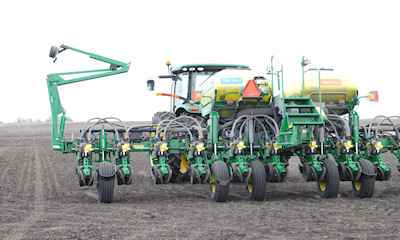May 24, 2015

By Steve Johnson
USDA's Farm Service Agency is notifying some farmers they need to make sure they have a conservation plan (form AD-1026) on file at their local FSA office. Deadline to do this is June 1, 2015. The 2014 Farm Bill requires producers to have the form on file in order to remain eligible, or to become eligible, for crop insurance premium support.

DEADLINE LOOMS: USDA is reminding farmers to file a Highly Erodible Land and Wetland Certification form (AD-1026) with their local USDA Service Center by June 1, 2015. Editor's Note: Steve Johnson is an Iowa State University Extension farm management specialist and regular contributor to this Farm Management Friday column. You can contact him at [email protected] or 515-957-5790.
This form is a continuous certification with descriptions for managing highly erodible land and wetland conservation. The form has existed since 1986, and the 2008 Farm Bill required that the form be signed and not violated in order to receive FSA farm program payments (DCP, Direct & Counter-Cyclical Program). The 2014 Farm Bill now ties conservation compliance to qualifying for crop insurance subsidies beginning with the 2016 crop. This will be as early as September 2015 for farmers who are planting winter wheat and March 15, 2016 for spring planted crops such as corn and soybeans.
Who does and who doesn't, need to have this form on file?
The June 1, 2015 deadline to have the AD-1026 on file is driven by USDA's Risk Management Agency. RMA has a July 1 deadline for their reinsurance agreement regarding 2016 crop insurance coverage for their crop insurance providers.
Most farm operators (including crop share landlords) have their AD-1026 forms already on file at FSA. Cash rent landlords don't receive USDA farm program payments or crop insurance subsidies, so they don't have to deal with this form. However, sometimes the farm name or names, or the Taxpayer ID, does not match the RMA's records. For example, a beginning farmer or someone who recently formed an LLC, or a farm corporation, etc. could be in this situation.
If FSA or a crop insurance agent sends you a message reminding you to check to see if you have an AD-1026 on file with your local FSA office, what should you do? Farm operators and crop share landlords should immediately contact their FSA office with questions about the AD-1026 form. The crop insurance subsidies for 2016 crop aren't lost until the AD-1026 form is not on file; or if the farm is out of conservation compliance, or until all compliance appeals are exhausted.
Why do you need to have AD-1026 on file at county FSA office?
It is important to contact your local FSA office to see if this form is indeed on file. If you want to receive USDA's ARC-PLC payments, or want to qualify for government loans (marketing loans, direct loans, guaranteed loans, grain storage facility loans) then you need to check with FSA before June 1.
And, keep in mind beginning in 2016 you need to have the form on file in order to qualify for crop insurance subsidies. So do it by June 1, 2015. You'll also need to remain in compliance on soil conservation practices outlined and called for in your continuous plan, to qualify to receive farm program benefits.
Here's the press release USDA issued May 21 as a reminder
USDA reminds farmers to file a Highly Erodible Land Conservation and Wetland Conservation Certification form (AD-1026) with their local USDA Service Center (www.fsa.usda.gov) by June 1, 2015. The 2014 Farm Bill requires producers to have the form on file to remain eligible, or become eligible for crop insurance premium support.
~~~PAGE_BREAK_HERE~~~
Many farmers already have a certification form on file since it's required for participation in most USDA programs including marketing assistance loans, farm storage facility loans and disaster assistance. However, farmers who only participate in the federal crop insurance program must now file a certification form to receive crop insurance premium support. These producers might include specialty crop farmers who may not participate in other USDA programs.
Take action to remain eligible for crop insurance premium support
"USDA is making every effort possible to get the word out about this new farm bill provision," said U.S. Agriculture Secretary Tom Vilsack. "We've deployed a variety of information documents and online resources including fact sheets, frequently asked questions and brochures to help farmers understand what they need to do."
"We've also conducted information meetings and training sessions for nearly 6,000 stakeholders across the country. We want to make sure the people who are required to act do so by the June 1 deadline. We want all eligible producers to be able to maintain their ability to protect their operations with affordable crop insurance."
Some farmers may be subject to compliance for first time
USDA has reached out especially to farmers who only participate in the federal crop insurance program and may be subject to conservation compliance for the first time. Along with the outreach done by crop insurance agents and companies, USDA efforts have included letters, postcards, phone calls, producer meetings and interaction with stakeholder groups to help them reach their members. While there are procedures in place to correct good faith errors and omissions on certification forms, the deadline cannot be waived or extended and a form must be filed by June 1.
The Highly Erodible Land Conservation & Wetland Conservation Certification form AD-1026 is available at USDA Service Centers or online at www.fsa.usda.gov/AD1026form. When a farmer completes the form, USDA's Farm Service Agency and Natural Resources Conservation Service staff will identify any additional actions that may be required for compliance with highly erodible land and wetland provisions. USDA's Risk Management Agency, through the Federal Crop Insurance Corporation, manages the federal crop insurance program.
For farm management information visit ISU's Ag Decision Maker site extension.iastate.edu/agdm; ISU farm management specialist Steve Johnson's site is at extension.iastate.edu/polk/farm-management
You May Also Like




